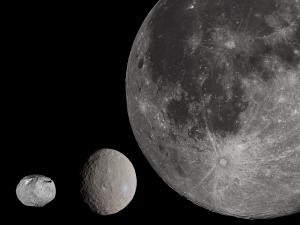Post
Alas, Poor Ceres
21 March 2013
 NASA/JPL-Caltech/UCAL/MPS/DLR/IDA
NASA/JPL-Caltech/UCAL/MPS/DLR/IDAIn 1801 a new planet was discovered in our solar system. Just twenty years earlier the planet Uranus was discovered beyond the orbit of Saturn, and was the first planet discovered since the dawn of civilization. The location of Uranus agreed with a (now defunct) model of planetary distances known as the Titus-Bode law, which had correctly predicted the distances of the known planets. But the Titus-Bode law also predicted the existence of a planet between Mars and Jupiter, which had not been seen until the discovery of this new planet. The 1801 planet had a distance within 1% of the prediction of Titus-Bode, and it was named after the Roman goddess of agriculture, Ceres.
Until the mid-1800s, Ceres was considered to be a planetary body. In less than a decade after the discovery of Ceres, three more planets were discovered between Mars and Jupiter, and given the names Pallas, Juno and Vesta. In 1846, Neptune was discovered beyond Uranus, raising the total number of planets in our solar system to 12. Within ten years of Neptune’s discovery, dozens of new planets were discovered between Mars and Jupiter: Astreae, Hebe, Iris, Flora, Metis, Hygiea, and the list continued to grow.
While Uranus and Neptune were similar to the historical planets, these new planets were very different. They all had roughly the same orbital distance (between Mars and Jupiter). They were also significantly smaller than the other planets, even much smaller than our moon. Rather, they were more like Ceres, itself a small, rocky body. It soon became clear that referring to all of these bodies as planets wasn’t very accurate. So they were put into a new category of Sun-orbiting objects: asteroids. Thus, Ceres lost its planetary status, demoted to King of the asteroids. The number of planets in our solar system was thereby reduced to eight.
In 1930 a new planet was discovered, and given the name Pluto. While Pluto was a small world (smaller than our Moon), it seemed alone beyond the orbit of Neptune. But in the 1990s more objects were discovered beyond the orbit of Neptune. By the mid-2000s, trans-Neptunian objects of a size similar to Pluto were discovered, and in 2005 one larger than Pluto was found. It was named Eris, and for a while enjoyed status as the tenth planet.
But by then it was clear that Pluto was not alone. Rather there were lots of objects that, like Pluto were small, icy and beyond the orbit of Neptune. Again it was clear that referring to all these bodies as planets wasn’t an accurate description. So in 2006 the International Astronomical Union formalized the definition of what constituted a planet. They had to orbit the Sun, they had to be massive enough to be roughly spherical, and they had to be distinct among objects of their distance. Pluto and Eris did not satisfy the last condition, being similar to other trans-Neptunian objects. Like Ceres before them, they lost their status as planets.
But the IAU also defined a secondary category for objects that satisfied the first two, but not the third. They were given the name dwarf planets. Under this definition, Pluto and Eris were categorized as dwarf planets. Ceres was also promoted to dwarf planet status, as were two other trans-Neptunian objects, Haumea and Makemake. So currently our solar system has 8 planets, 5 dwarf planets, and countless other small solar system bodies.
As our understanding of the solar system has grown, we have had to refine our naive concept of what makes a planet. If you mourn Pluto’s exclusion from the solar planets, you should also mourn Ceres, who suffered her loss a century earlier.